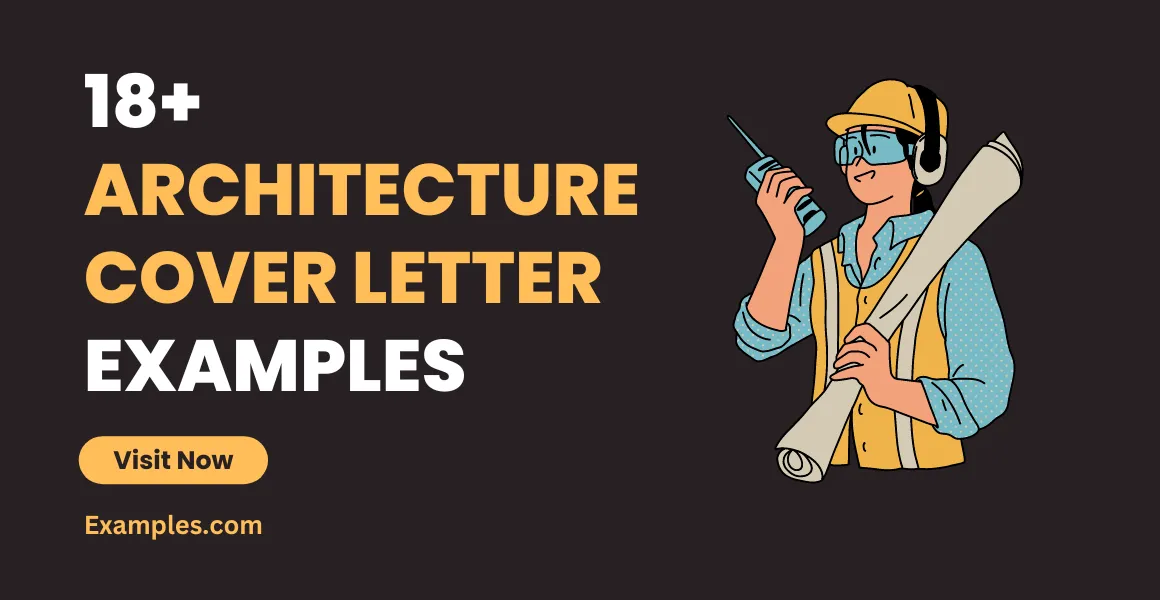What is an Architecture Cover Letter
An architecture cover letter is a crucial document that accompanies your resume when applying for an architecture job. It serves as your introduction to a potential employer, offering you the opportunity to showcase your skills, experience, and personality beyond the confines of your resume. Think of it as your personal sales pitch, designed to persuade the hiring manager that you are the ideal candidate for the position. A well-crafted cover letter can significantly increase your chances of landing an interview, while a poorly written one can lead to your application being immediately rejected.
Why is an Architecture Cover Letter Important
In the competitive field of architecture, a cover letter provides a unique opportunity to differentiate yourself from other applicants. It demonstrates your communication skills, attention to detail, and genuine interest in the specific role and company. It allows you to explain your qualifications and how they align with the job requirements, and to highlight your passion for architecture. Moreover, a cover letter showcases your personality, giving the hiring manager a glimpse into who you are beyond your technical skills. This can be especially important in a field where collaboration and communication are essential.
Key Components of a Successful Architecture Cover Letter
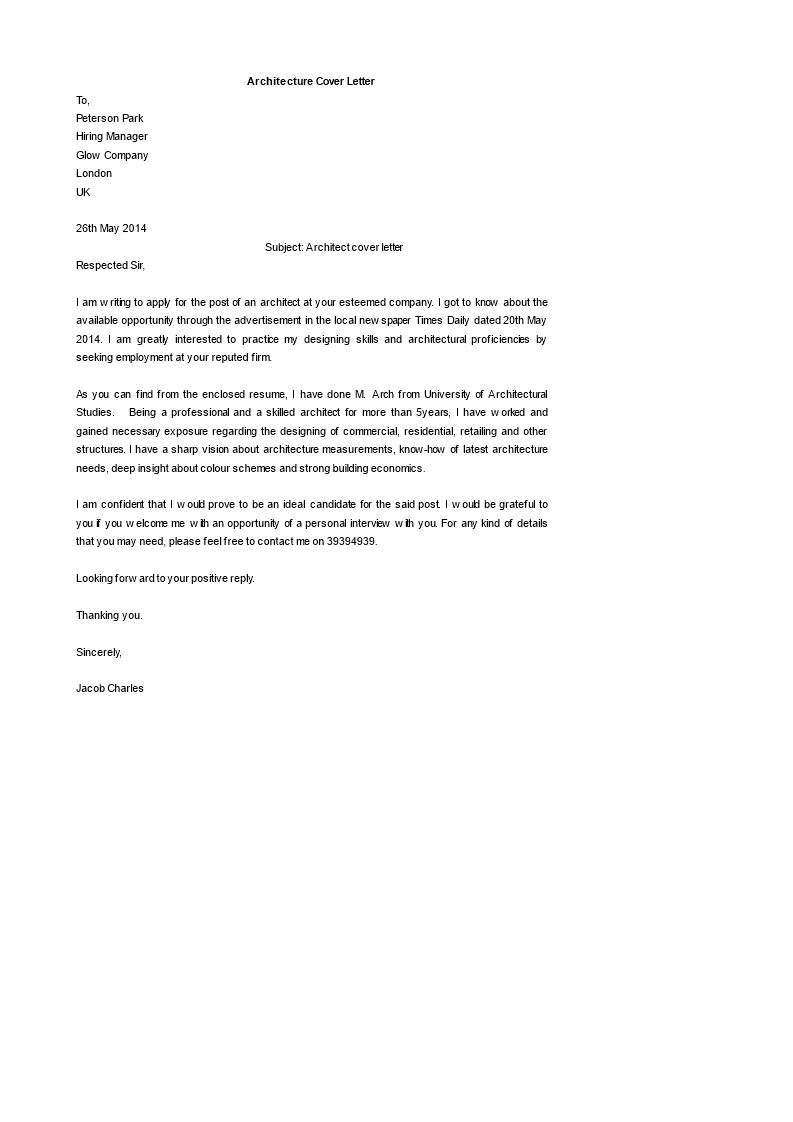
Header and Contact Information
Start your cover letter with a professional header that includes your name, address, phone number, and email address. This information ensures that the hiring manager can easily contact you. Ensure your contact information is up-to-date and professional. Consider using a simple and elegant font for your header to maintain a clean and professional appearance. Including a link to your online portfolio (if you have one) is also a good idea, as it allows the employer to quickly view your work.
Recipient’s Details
Always address your cover letter to a specific person, if possible. Research the company and identify the hiring manager or the person responsible for reviewing applications. Addressing your letter to a specific individual demonstrates your attention to detail and initiative. If you are unable to find a specific name, you may use a general salutation like “Dear Hiring Manager”. Avoid generic greetings such as “To Whom It May Concern”, as these lack personalization and can make your letter feel less engaging.
Professional Salutation
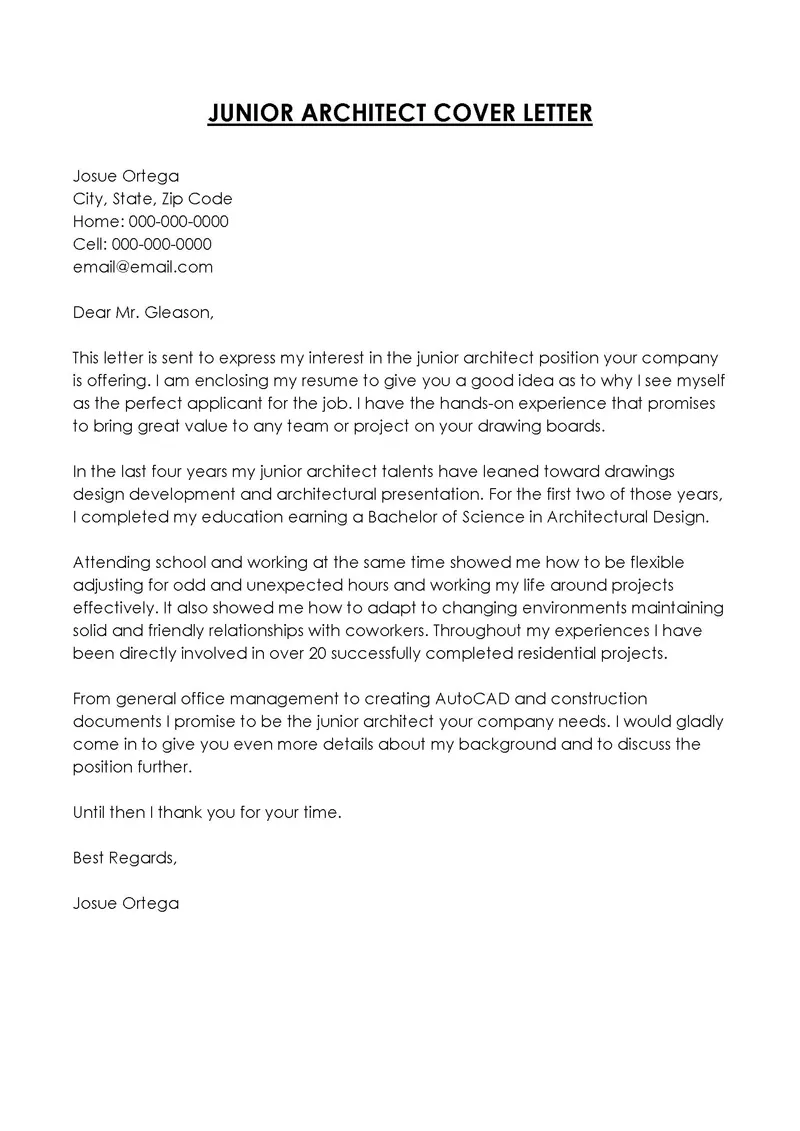
Use a professional salutation, such as “Dear Mr./Ms./Mx. [Last Name]” or “Dear Hiring Manager”. If you know the name of the hiring manager, use their proper title and last name. This personal touch immediately establishes a respectful tone. If you are unsure of the person’s gender, use “Mx.” as a gender-neutral option. Avoid overly casual greetings such as “Hi” or “Hello” in a professional cover letter.
Opening Paragraph Grab Their Attention
Your opening paragraph is your chance to capture the reader’s attention. Start with a strong statement that clearly states the position you are applying for and where you found the job posting. Briefly mention why you are interested in the role and the company. You can also include a brief sentence highlighting your key qualifications or a notable achievement. The goal is to make the hiring manager want to read further. Keep the opening paragraph concise and focused.
Highlighting Relevant Skills and Experience
Showcasing Your Architectural Skills
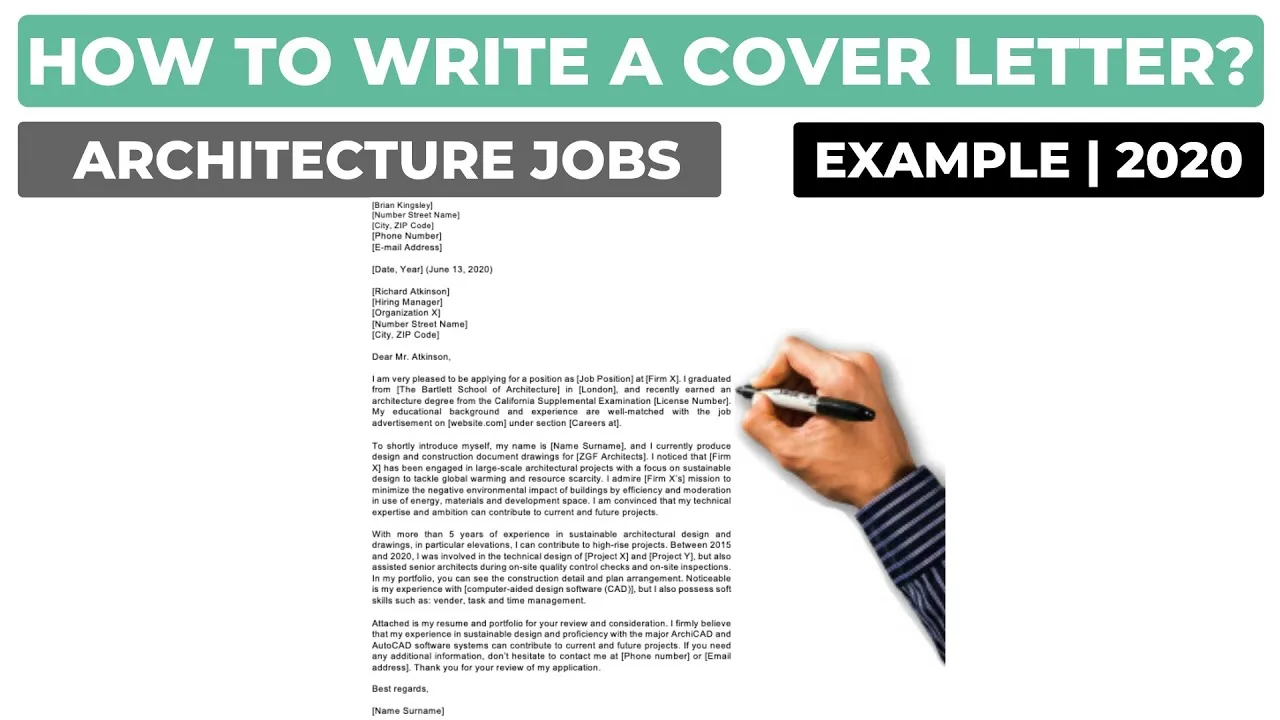
Clearly outline your architectural skills, emphasizing those that are relevant to the job description. Mention your proficiency in design software, such as AutoCAD, Revit, SketchUp, or others. Describe your experience with building codes, construction documents, and project management. Use action verbs to describe your skills (e.g., designed, managed, collaborated). Tailor the skills you mention to match the specific requirements listed in the job posting. Quantify your skills whenever possible, using numbers and statistics to demonstrate your achievements.
Demonstrating Project Experience
Provide specific examples of your project experience. Briefly describe the projects you have worked on, including your role, the project’s scope, and your responsibilities. Focus on the projects that are most relevant to the job you are applying for. Mention the types of projects you have experience with (e.g., residential, commercial, institutional). Highlight any unique challenges you faced and how you overcame them. Include details about your contributions to the project’s success.
Quantifying Achievements and Results
Whenever possible, quantify your achievements and results. Instead of saying you “managed projects,” state that you “managed projects with budgets up to $X.” Instead of saying you “improved efficiency,” state that you “improved project efficiency by X%.” Use numbers and data to demonstrate the impact of your work. This provides concrete evidence of your capabilities and shows the value you can bring to the company. Use specific examples to support your claims.
Expressing Passion for Architecture and the Company
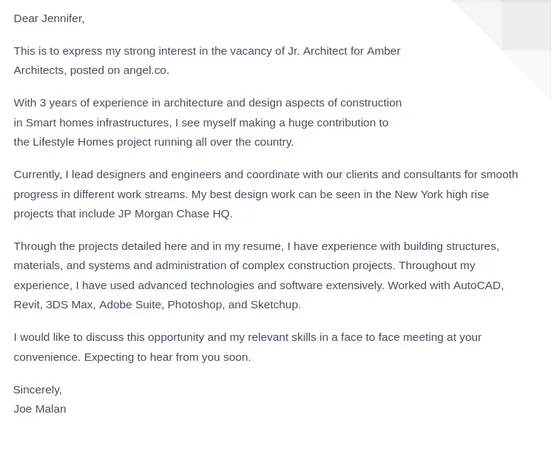
Researching the Company and Showing Interest
Show that you’ve researched the company and are genuinely interested in working there. Mention specific projects or aspects of the company’s work that resonate with you. Demonstrate your knowledge of the company’s values, mission, and culture. This shows that you are not just sending out a generic cover letter, but that you are specifically interested in this particular opportunity and company. Visit the company’s website, read their blog, and follow them on social media.
Articulating Your Career Goals
Briefly articulate your career goals and how this position aligns with them. Explain why you believe this role will help you grow professionally and contribute to your long-term career objectives. This demonstrates that you are a strategic thinker and that you have a clear vision for your future. Show the hiring manager how this role fits into your overall career trajectory. Express your enthusiasm for the opportunity to learn and develop within the company.
Adding a Compelling Closing Paragraph
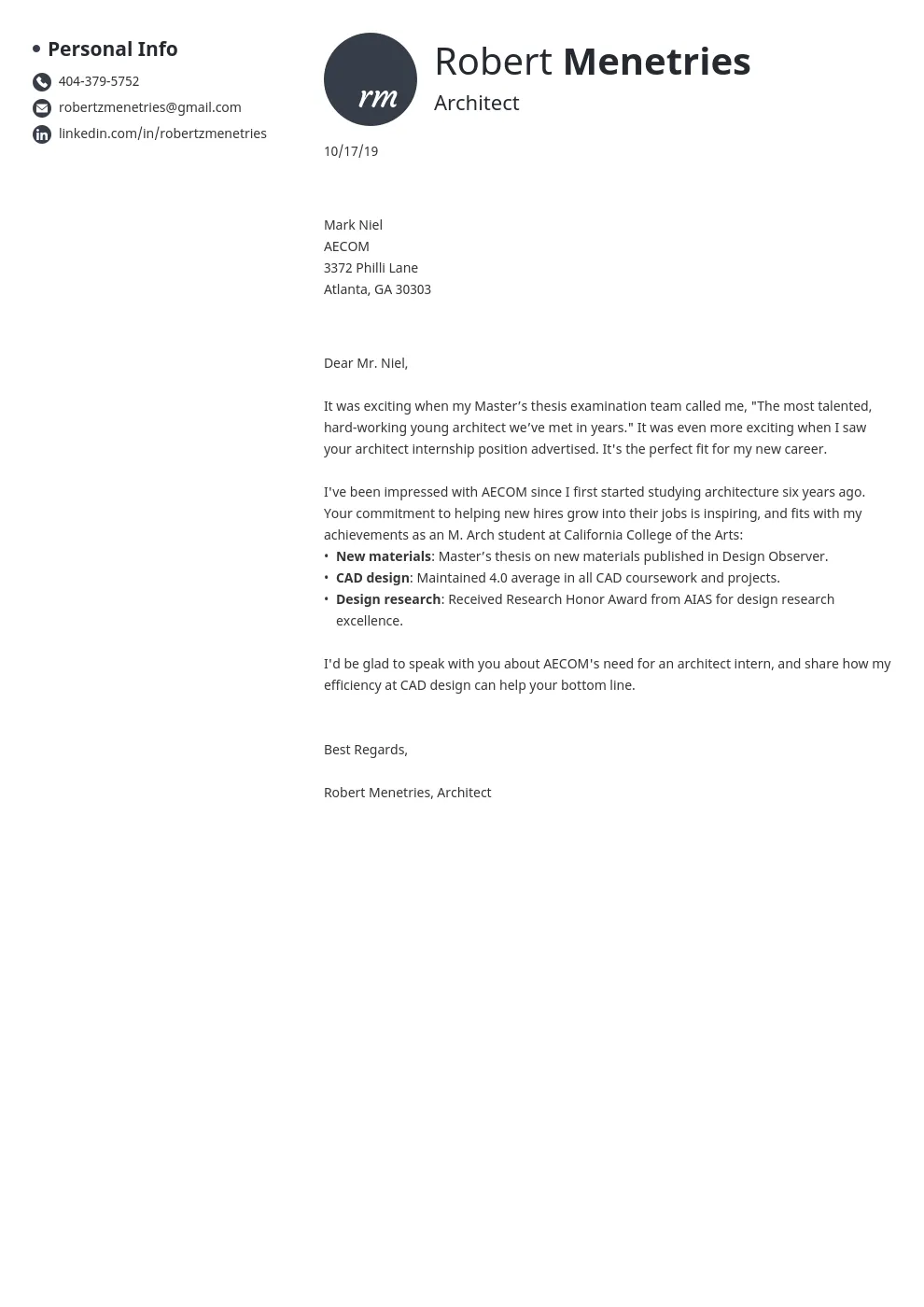
Reiterating Interest and Call to Action
In your closing paragraph, reiterate your interest in the position and express your enthusiasm for the opportunity to contribute to the company. End with a clear call to action, such as requesting an interview or expressing your availability to discuss your qualifications further. Make it easy for the hiring manager to take the next step. Thank the hiring manager for their time and consideration.
Formal Closing and Signature
Use a formal closing such as “Sincerely,” “Best regards,” or “Yours sincerely.” Follow your closing with your typed name. If submitting a printed cover letter, leave space for your handwritten signature above your typed name. Your signature adds a personal touch and reinforces your professionalism. Ensure your signature is legible and represents your commitment to the position.
Formatting and Design Tips for Your Architecture Cover Letter
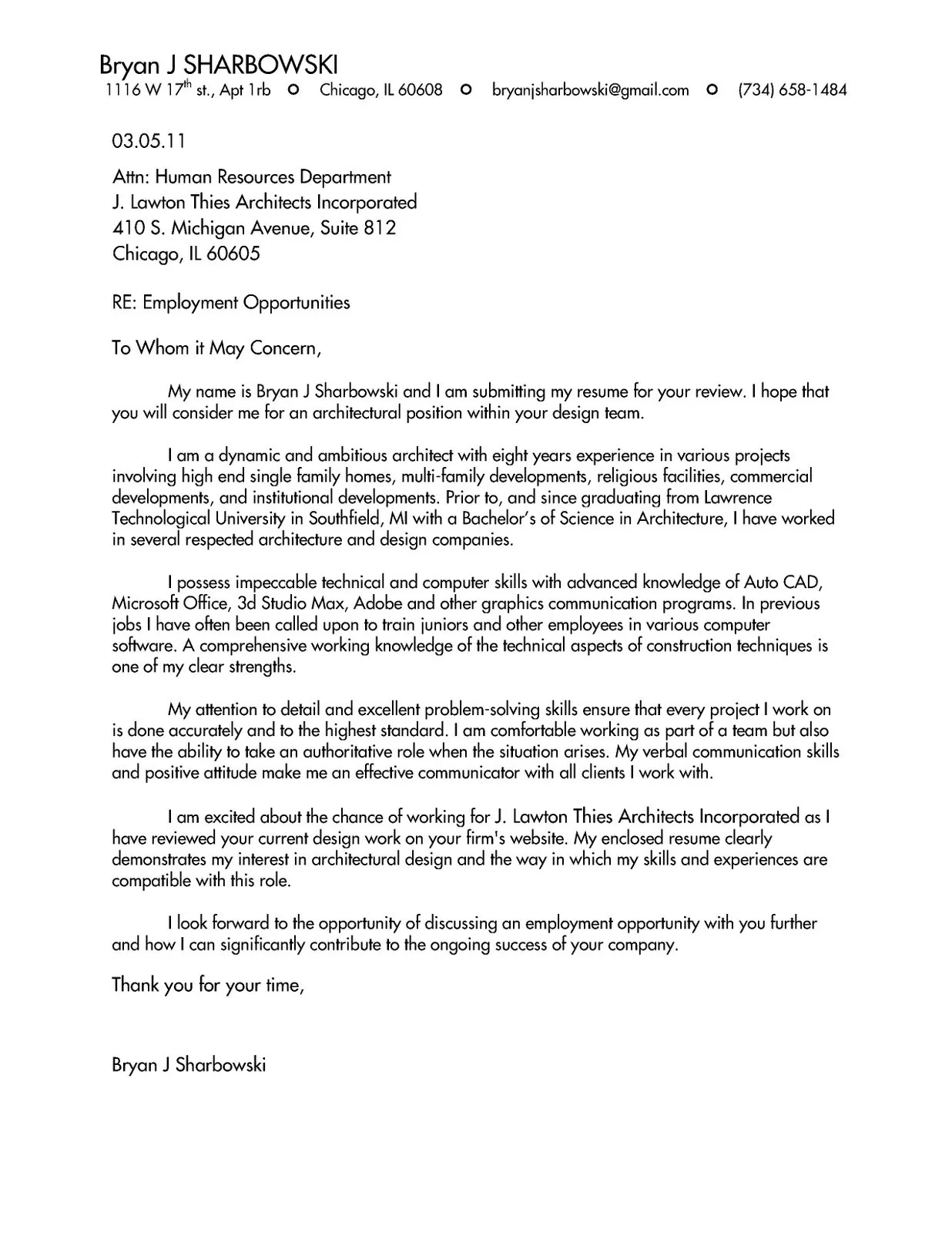
Font Selection and Readability
Choose a professional and easy-to-read font, such as Times New Roman, Arial, Calibri, or Helvetica. Use a font size between 10 and 12 points. Ensure the font is consistent throughout the document. Avoid using overly decorative or unusual fonts that could distract the reader. The goal is to make your cover letter easy to read and visually appealing, not to create a design masterpiece.
Layout and White Space
Use a clean and well-organized layout with ample white space. Use single-spacing within paragraphs and double-spacing between paragraphs. Use left alignment and avoid justifying the text. Maintain consistent margins throughout the document. A well-formatted cover letter is easier to read and creates a positive impression. Proper layout guides the reader’s eye and makes the content more accessible.
Proofreading and Editing
Thoroughly proofread and edit your cover letter before submitting it. Check for any typos, grammatical errors, and punctuation mistakes. Have a friend or colleague review your letter for any errors you may have missed. Errors can undermine your credibility and demonstrate a lack of attention to detail. Ensure your writing is clear, concise, and error-free. A polished cover letter reflects your professionalism and commitment to excellence.
Common Mistakes to Avoid
Generic Cover Letters
Avoid using a generic cover letter that could be sent to any company. Customize your cover letter for each job application, tailoring it to the specific requirements and the company’s values. Show that you have researched the company and understand what they are looking for. Generic cover letters show a lack of interest and can lead to your application being rejected. Personalization demonstrates your genuine interest in the role and the company.
Typos and Grammatical Errors
Typos and grammatical errors can damage your credibility and make you appear unprofessional. Always proofread your cover letter carefully before submitting it. Use a grammar checker and ask a friend or colleague to review your letter for any mistakes. Errors suggest a lack of attention to detail, which is critical in architecture. Presenting a flawless cover letter shows your respect for the position and the company.
Ignoring the Job Description
Carefully read the job description and tailor your cover letter to address the specific requirements listed. Highlight the skills and experience that match the job’s requirements. Use the same keywords and phrases from the job description to show that you are a good fit. Ignoring the job description suggests that you haven’t put in the effort to understand the role. Demonstrate that you have the skills and experience the company is looking for.
Cover Letter Examples
Review cover letter examples to get an idea of how to structure your own letter. Look for examples that are relevant to your experience and the type of job you are applying for. You can find numerous cover letter templates and examples online. However, remember to customize any template you use to reflect your unique skills and experience. Ensure that the example aligns with industry standards and best practices.
Cover Letter for Architecture Job
The cover letter for an architecture job should emphasize your design skills, project experience, and knowledge of architectural principles. Showcase your proficiency in relevant software and your understanding of building codes. Highlight your ability to collaborate with other professionals and manage projects effectively. Tailor the cover letter to the specific requirements of the job and the company’s values.
Cover Letter for Intern Architecture
A cover letter for an architecture internship should focus on your educational background, relevant coursework, and any practical experience you may have. Highlight your enthusiasm for the field and your willingness to learn and contribute. Express your interest in the company and your eagerness to gain practical experience. Mention any skills you have that are relevant to the internship role.
